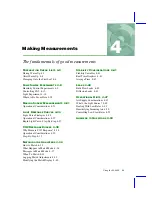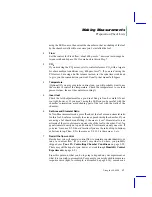
Making Measurements
Some Simple Experiments
Using the LI-6400
4-15
centration: 400, 300, 200, 100, and 30 (C
3
) or 0 (C
4
). The last point is de-
signed to be below the compensation point.
Question #11:
Notice when you change the CO
2
concentration (whether you
did it with the mixer, or the soda lime tube scrub knob) the indicated photo-
synthetic rate (
Photo
) becomes quite erratic. Why? (Answer on page 4-54.)
Question #12:
If you are controlling CO
2
by varying the soda lime scrub
knob, under what circumstances might you expect changes in this knob set-
ting to affect the flow rate through the chamber? (Hint: itÕs a humidity control
question. Answer on page 4-54.)
5
Wait for stability, then match and log
Wait for a minute or so for the photosynthetic rate to stabilize, match the IR-
GAs, then log another record (
f1
level 1).
6
Repeat until done
Repeat Steps 4 and 5 until you are done. Try to get about 4 or 5 points between
your starting value and ending points. Go down to 30 µmol mol
-1
or so for C
3
plants, and 0 for C
4
Õs. (Hint: If you are using the CO
2
mixer, you get 0
µmol mol
-1
by turning the mixer off.)
At any point along the way, you can view a graph of your logged data by do-
ing Step 8.
7
Finish the curve back at the starting point
Repeat the starting point. See how long it takes for the photosynthetic rate to
return to normal. (Hint: donÕt spend too long at lowest CO
2
value.)
If you have a CO
2
controller, do some points above ambient, such as 600,
800, and 1000 µmol mol
-1
. (If global warming scenarios are keeping you
funded, go right on up to 2000.)
8
View the Graph
You can view your curve with GraphIt (press
View File
(
f2
level 1 in New
Measurements mode). If the axes are not defined for an A-Ci, press
QuikPik Config
(
f1
) and select ÒA_Ci CurveÓ. Press
REPLOT GRAPH
(
f2
) and
draw it. Hint: If your low CO
2
point had negative photosynthesis (respira-
tion), you may want to change the default A-Ci plotting to automatically scale
the axis minimum for photosynthesis. Otherwise, it wonÕt show that point.
Summary of Contents for LI-6400
Page 1: ...Using the LI 6400 Portable Photosynthesis System ...
Page 15: ...Part I The Basics ...
Page 16: ......
Page 174: ...Making Measurements Answers to Questions 4 56 Using the LI 6400 4 ...
Page 175: ...Part II Useful Details ...
Page 176: ......
Page 200: ...Standard Tools Power ON Hooks 5 24 Using the LI 6400 5 ...
Page 214: ...Real Time Data Real Time Graphics 6 14 Using the LI 6400 6 ...
Page 234: ...Environmental Control Light Control 7 20 Using the LI 6400 7 ...
Page 244: ...Light Sensor Considerations Gallium Arsenide Phosphide GaAsP Sensor 8 10 Using the LI 6400 8 ...
Page 288: ...Data Logging Making Your Own AutoPrograms 9 44 Using the LI 6400 9 ...
Page 289: ...Part III Working With Files ...
Page 290: ......
Page 312: ...The LPL File System Troubleshooting 10 22 Using the LI 6400 10 ...
Page 340: ...Downloading Files Using a Data Capture Program 11 28 Using the LI 6400 11 ...
Page 375: ...Part IV Configuration Issues ...
Page 376: ......
Page 420: ...Defining User Variables Old Style vs New Style 15 18 Using the LI 6400 15 ...
Page 454: ...Using an Energy Balance Further Reading 17 12 Using the LI 6400 17 ...
Page 455: ...Part V Maintenance Troubleshooting ...
Page 456: ......
Page 572: ...Troubleshooting Useful Information 20 46 Using the LI 6400 20 ...
Page 593: ...Part VI Programming ...
Page 594: ......
Page 622: ...Programming with LPL Compiler Directives 22 28 Using the LI 6400 22 ...
Page 846: ...Index I 16 Using the LI 6400 ...
















































